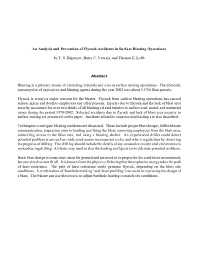Mining Publication: An Analysis and Prevention of Flyrock Accidents in Surface Blasting Operations
Original creation date: February 2004
Blasting is a primary means of extracting minerals and ores at surface mining operations. The consumption of explosives and blasting agents during the year 2002 was about 5.53 billion pounds. Flyrock is always a major concern for the blaster. Flyrock from surface blasting operations serious injury and death to employees and other persons. Injuries due to flyrock and the lack security accounted for over two-thirds of all blasting-related injuries in surface coal, metal, and mines during the period 1978-2002. Selected accidents due to flyrock and lack of blast area surface mining are presented in this paper. Incidents related to construction blasting are also Techniques to mitigate blasting accidents are discussed. These include proper blast design, driller-communication, inspection prior to loading and firing the blast, removing employees from the controlling access to the blast area, and using a blasting shelter. An experienced driller potential problem areas such as voids, mud seams, incompetent rocks, and other irregularities the progress of drilling. The drill log should include the details of any unusual or exceptional circumstances noticed during drilling. A blaster may need to alter the loading configuration to alleviate potential Basic blast design is sometimes taken for granted and assumed to be proper for the conditions encountered, but one size does not fit all. It is known from the physics of blasting that the explosive energy takes of least resistance. The path of least resistance could generate flyrock, depending on the conditions. A combination of ‘borehole tracking' and ‘laser profiling' can assist in improving a blast. The blaster can use these tools to adjust borehole loading to match site conditions.
Authors: TS Bajpayee, HC Verakis, TE Lobb
Conference Paper - February 2004
NIOSHTIC2 Number: 20024278
Proc 30th Ann Conf Explos Blasting Tech, New Orleans, LA, February 1-4, 2004, 2004 Feb; :1-10
See Also
- Analysis of Mine Fires for All U.S. Underground and Surface Coal Mining Categories: 1990-1999
- Blasting Injuries in Surface Mining with Emphasis on Flyrock and Blast Area Security
- Blasting Safety - Revisiting Site Security
- Dangers of Toxic Fumes from Blasting
- Fatal Accidents Due to Flyrock and Lack of Blast Area Security and Working Practices in Mining
- A Hydrodynamics-Based Approach for Predicting the Blast Damage Zone in Drifting as Demonstrated Using Concrete Block Data
- Safety Analysis of Surface Haulage Accidents
- A Summary of Fatal Accidents Due to Flyrock and Lack of Blast Area Security in Surface Mining, 1989 to 1999
- Technology News 522 - Blast Area Security: Flyrock Safety
- Toolbox Training on Flyrock Awareness
- Page last reviewed: 9/21/2012
- Page last updated: 9/21/2012
- Content source: National Institute for Occupational Safety and Health, Mining Program


 ShareCompartir
ShareCompartir
